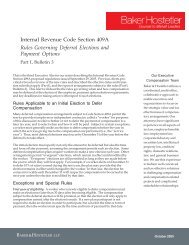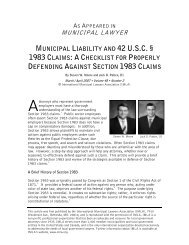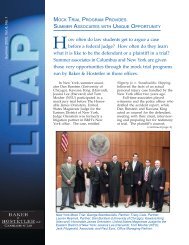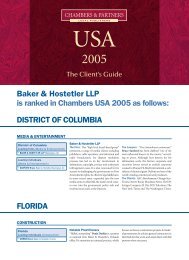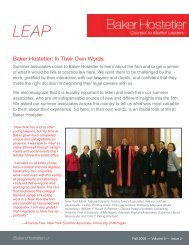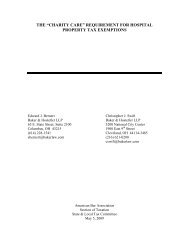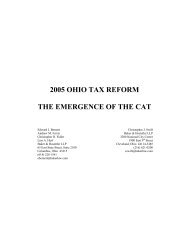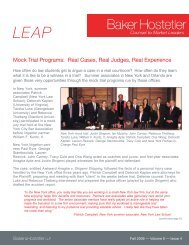Prejudgment Remedies in Texas - Doug D'Arche - Back to Main Page
Prejudgment Remedies in Texas - Doug D'Arche - Back to Main Page
Prejudgment Remedies in Texas - Doug D'Arche - Back to Main Page
- No tags were found...
You also want an ePaper? Increase the reach of your titles
YUMPU automatically turns print PDFs into web optimized ePapers that Google loves.
There are several different types of liens that may be enforced us<strong>in</strong>g a Writ ofSequestration. The most common type of lien is a purchase money security <strong>in</strong>terest under theUCC (Tex. Bus. & Comm. Code § 9.001 et seq.). Other liens <strong>in</strong>clude constitutional liens <strong>to</strong>orig<strong>in</strong>al contrac<strong>to</strong>rs provid<strong>in</strong>g goods or services used <strong>in</strong> construction (Tex. Const. Art. XV1, §37), statu<strong>to</strong>ry liens for mechanics, artisans and materialmen (Tex. Prop. Code § 53.001 et seq.),and statu<strong>to</strong>ry liens for farm, fac<strong>to</strong>ry and s<strong>to</strong>re workers (Tex. Prop. Code § 58.001 et seq.).4. Contents of the Application and Support<strong>in</strong>g AffidavitThe application must be supported by affidavits of the Credi<strong>to</strong>r, its agent, its at<strong>to</strong>rney, orother persons hav<strong>in</strong>g knowledge of relevant facts. Tex. R. Civ. P. 696; Monroe v. GMAC, 573S.W.2d 591, 593 (Tex. Civ. App.—Waco 1978, no writ). The application and the affidavit mustconta<strong>in</strong> the follow<strong>in</strong>g:1. a statement of the grounds for issuance of the Writ as set forth <strong>in</strong> <strong>Texas</strong> Rule ofCivil Procedure 62.001;2. a description of the property <strong>to</strong> be sequestered with such certa<strong>in</strong>ty that it may beidentified and dist<strong>in</strong>guished from property of a like k<strong>in</strong>d, giv<strong>in</strong>g the value of eacharticle of the property and the county <strong>in</strong> which it is located;3. the specific facts relied upon by the Credi<strong>to</strong>r <strong>to</strong> warrant the required f<strong>in</strong>d<strong>in</strong>gs bythe Court.Tex. R. Civ. P. 696.As a practical matter, the application should also conta<strong>in</strong> the specific facts stat<strong>in</strong>g thenature of the Credi<strong>to</strong>r's claim and the amount <strong>in</strong> controversy. The value of the property <strong>to</strong> becovered must be with<strong>in</strong> the Court's jurisdictional limits. Moore v. First State Bank of Liv<strong>in</strong>gs<strong>to</strong>n,127 S.W.2d 536, 538 (Tex. Civ. App.—Beaumont 1939, no writ).The description of the property must be specific enough so that the levy<strong>in</strong>g officer canidentify the property. Tex. R. Civ. P. 696. Although the description of the property <strong>in</strong> theApplication for Writ of Sequestration must be specific enough so that the property may beidentified from property of a like k<strong>in</strong>d, giv<strong>in</strong>g the value of each article, when the Credi<strong>to</strong>r isseek<strong>in</strong>g sequestration of an <strong>in</strong>ven<strong>to</strong>ry, it is not necessary <strong>to</strong> allege the value of each <strong>in</strong>dividualitem. The Credi<strong>to</strong>r may allege the value of the <strong>to</strong>tal <strong>in</strong>ven<strong>to</strong>ry. Marrs v. South <strong>Texas</strong> Nat. Bank,686 S.W.2d 675, 678 (Tex. App.—San An<strong>to</strong>nio 1985, writ ref'd n.r.e.). If the Writ ofSequestration misdescribes the property <strong>to</strong> be sequestered, it is a fatal error. Watts v.Overstreet, 14 S.W. 704, 705-706 (Tex. 1890). As a general rule, if the Credi<strong>to</strong>r has <strong>in</strong>formationsuch as a serial number or a Vehicle Identification Number, that <strong>in</strong>formation should be <strong>in</strong>cluded<strong>in</strong> the application and support<strong>in</strong>g affidavit.The affidavit support<strong>in</strong>g the Application for Writ of Sequestration shall be made onpersonal knowledge and shall set forth such facts as would be admissible <strong>in</strong><strong>to</strong> evidenceprovided that they may be stated based on <strong>in</strong>formation and belief if the grounds of such beliefare specifically stated. Tex. R. Civ. P. 696. The person execut<strong>in</strong>g the affidavit must be a personwith knowledge of relevant facts. Monroe v. GMAC, 573 S.W.2d 591, 593 (Tex. Civ. App.—Waco 1978, no writ). Generally, the Court will focus more on the facts that are based uponpersonal knowledge and will not look favorably upon matters based on <strong>in</strong>formation and beliefunless the circumstantial evidence is very strong.<strong>Page</strong> 16 of 36



